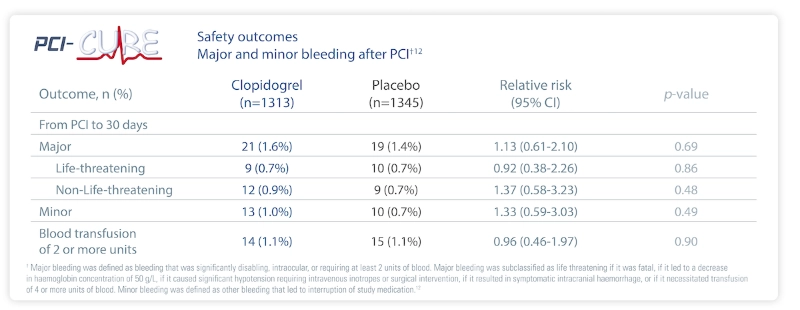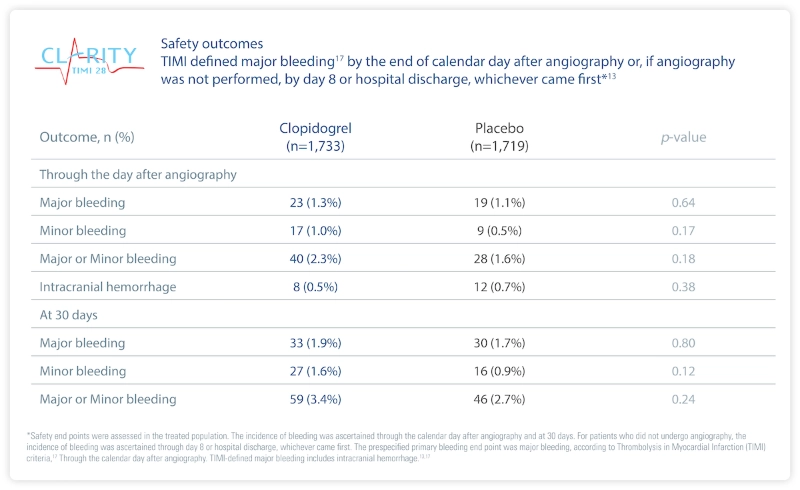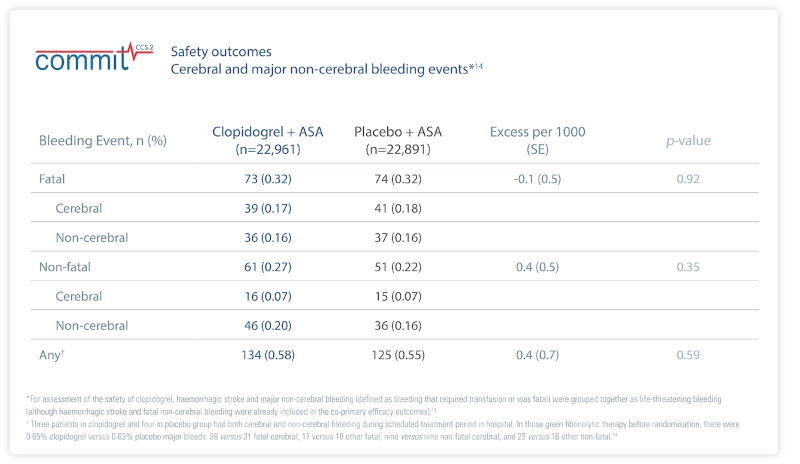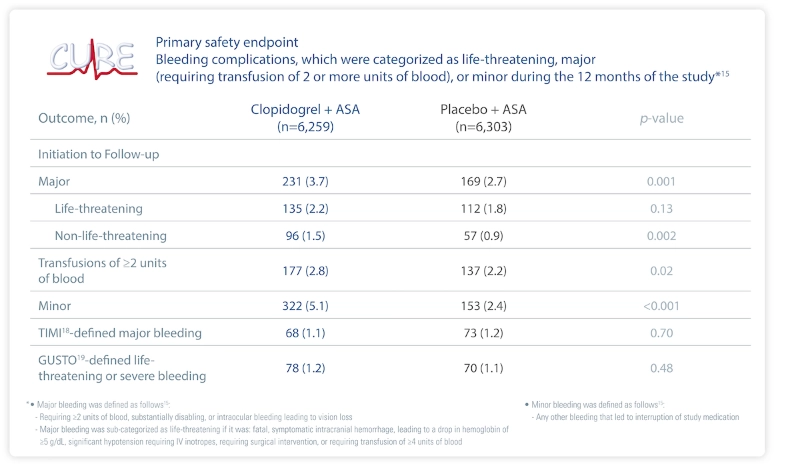Plavix®

Tolerability
Plavix showed well demonstrated safety profile
*Safety outcomes were analyzed according to the treatment actually received by each patient. Bleeding events were categorized according to the Thrombolysis in Myocardial Infarction criteria.1,7
Adapted from Table 4. Safety Outcomes, The PCI-CLARITY Study. JAMA. 2005;294(10):1224–1232

† Major bleeding was defined as bleeding that was significantly disabling, intraocular, or requiring at least 2 units of blood. Major bleeding was subclassified as life threatening if it was fatal, if it led to a decrease in haemoglobin concentration of 50 g/L, if it caused significant hypotension requiring intravenous inotropes or surgical intervention, if it resulted in symptomatic intracranial haemorrhage, or if it necessitated transfusion of 4 or more units of blood. Minor bleeding was defined as other bleeding that led to interruption of study medication.2
Adapted from Table 5: Bleeding after PCI, The PCI-CURE study. Lancet. 2001 Aug 18;358(9281):527-33

*Safety end points were assessed in the treated population. The incidence of bleeding was ascertained through the calendar day after angiography and at 30 days. For patients who did not undergo angiography, the incidence of bleeding was ascertained through day 8 or hospital discharge, whichever came first. The prespecified primary bleeding end point was major bleeding, according to Thrombolysis in Myocardial Infarction (TIMI) criteria,7 Through the calendar day after angiography. TIMI-defined major bleeding includes intracranial hemorrhage.3,7
Adapted from Table 3. Safety Outcomes, The CLARITY TIMI Study. N Engl J Med. 2005 Mar 24;352(12):1179-89

*For assessment of the safety of clopidogrel, haemorrhagic stroke and major non-cerebral bleeding (defined as bleeding that required transfusion or was fatal) were grouped together as life-threatening bleeding (although haemorrhagic stroke and fatal non-cerebral bleeding were already included in the co-primary efficacy outcomes).4
† Three patients in clopidogrel and four in placebo group had both cerebral and non-cerebral bleeding during scheduled treatment period in hospital. In those given fibrinolytic therapy before randomisation, there were 0·65% clopidogrel versus 0·63% placebo major bleeds: 28 versus 31 fatal cerebral; 17 versus 18 other fatal; nine versus nine non-fatal cerebral; and 23 versus 16 other non-fatal.4
Adapted from Table 4: Effects of clopidogrel on cerebral and major non-cerebral bleeding during scheduled treatment period in hospital. The COMMIT Study. Lancet. 2005 Nov 5;366(9497):1607-21

• Major bleeding was defined as follows5:
- Requiring ≥2 units of blood, substantially disabling, or intraocular bleeding leading to vision loss
- Major bleeding was sub-categorized as life-threatening if it was: fatal, symptomatic intracranial hemorrhage, leading to a drop in hemoglobin of ≥5 g/dL, significant hypotension requiring IV inotropes, requiring surgical intervention, or requiring transfusion of ≥4 units of blood
• Minor bleeding was defined as follows5:
- Any other bleeding that led to interruption of study medication
Adapted from Table 3. Bleeding Complications. The CURE Study. N Engl J Med. 2001 Aug 16;345(7):494-502
- Sabatine MS, Cannon CP, Gibson CM, et al. Effect of Clopidogrel Pretreatment Before Percutaneous Coronary Intervention in Patients With ST-Elevation Myocardial Infarction Treated with Fibrinolytics: The PCI-CLARITY Study. JAMA. 2005;294(10):1224–1232.
- Mehta SR et al. Effects of pretreatment with clopidogrel and aspirin followed by long-term therapy in patients undergoing percutaneous coronary intervention: the PCI-CURE study. Lancet. 2001 Aug 18;358(9281):527-33.
- Sabatine MS et al. Addition of clopidogrel to aspirin and fibrinolytic therapy for myocardial infarction with ST-segment elevation. N Engl J Med. 2005 Mar 24;352(12):1179-89.
- Chen ZM et al. Addition of clopidogrel to aspirin in 45,852 patients with acute myocardial infarction: randomized placebo-controlled trial. Lancet. 2005 Nov 5;366(9497):1607-21.
- Yusuf S et al. Clopidogrel in Unstable Angina to Prevent Recurrent Events Trial Investigators. Effects of clopidogrel in addition to aspirin in patients with acute coronary syndromes without ST-segment elevation. N Engl J Med. 2001 Aug 16;345(7):494-502.
- The TIMI Study Group. The Thrombolysis in Myocardial Infarction (TIMI) trial: Phase I findings. N Engl J Med. 1985 Apr 4;312(14):932-6.
- Bovill EG et al. Hemorrhagic events during therapy with recombinant tissue-type plasminogen activator, heparin, and aspirin for acute myocardial infarction: results of the Thrombolysis in Myocardial Infarction (TIMI), Phase II Trial. Ann Intern Med. 1991 Aug 15;115(4):256-65.
- Chesebro JH et al. Thrombolysis in Myocardial Infarction (TIMI) Trial, Phase I: A comparison between intravenous tissue plasminogen activator and intravenous streptokinase. Clinical findings through hospital discharge. Circulation. 1987 Jul;76(1):142-54.
- GUSTO investigators. An international randomized trial comparing four thrombolytic strategies for acute myocardial infarction. N Engl J Med. 1993 Sep 2;329(10):673-82.
MAT-BH-2100412/v2/Jul 2023

.png)
